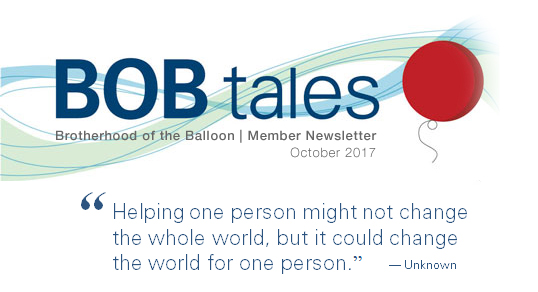
Dear Members (a note from Deb Hickey):
Last month, a record-shattering storm devastated much of southeast Texas and southwest Louisiana. Hundreds of thousands of people were evacuated or stranded. At least 40 people were killed. I couldn’t help but think of our nearly 500 members living in Texas (about 60 in Houston) and 30 in Louisiana.
Three weeks later, another powerful hurricane made landfall in Florida after causing catastrophic damage in Barbuda, Saint Barts, Saint Martin, Anguilla, and the Virgin Islands. More than 80 people were killed, including 38 from the U.S. Again, we thought of our members and their families. We have about 600 members living in Florida and a few in the Virgin Islands.
I pray daily for those who were affected by Hurricanes Harvey or Irma, especially our 1,100 members who were in the storm’s path. I hope you and your families are safe and that you haven’t suffered any health issues or serious property damage.
Note that Bob Marckini and I both donated to the Red Cross to support relief efforts in Texas and Florida. We encourage all of you to do the same.
.jpg) The hurricanes were yet another reminder to me that life is fragile. That’s why I live my life much differently after my husband’s pancreatic cancer diagnosis three years ago. I try not to sweat the small stuff; I spend more time with family and friends; I try new things as often as possible (Like taking trapeze lessons!); and perhaps most important, I try to do something every day to make someone else happy, whether it’s my husband, my daughter, my neighbor, or a stranger. With that in mind, did you know October 5 is “Do Something Nice Day?” Why not take your friend to lunch or offer to help rake your neighbor’s leaves (is it autumn already?).
The hurricanes were yet another reminder to me that life is fragile. That’s why I live my life much differently after my husband’s pancreatic cancer diagnosis three years ago. I try not to sweat the small stuff; I spend more time with family and friends; I try new things as often as possible (Like taking trapeze lessons!); and perhaps most important, I try to do something every day to make someone else happy, whether it’s my husband, my daughter, my neighbor, or a stranger. With that in mind, did you know October 5 is “Do Something Nice Day?” Why not take your friend to lunch or offer to help rake your neighbor’s leaves (is it autumn already?).
Another special date is October 27th—“Navy Day”—a day to salute all of the women and men who have served in the United States Navy. We have lots of members who proudly served in the Navy? One of them is Capt. Fred Spruell from Paradise, CA. He was treated with protons in 2004 at Loma Linda University Cancer Center. His urologist got up and walked out of the office when Fred told him he was going to have proton therapy. Read Fred’s interesting story in this month’s Giving Back section.
Incidentally, October is also International Dinosaur Month. Do what you want with that.
Looking ahead to November, we’d like to know if any of our members plan to take part in the tradition of “Movember.” Movember is an annual event involving the growing of mustaches during the month of November to raise awareness of men’s health issues, such as prostate cancer. If you have a mustache, shave it off! Hopefully your drastic facial change sparks conversations about proton therapy for prostate cancer. Will you be taking part in this tradition? Let us know!
Like all BOB Tales, this issue covers a lot of territory. There’s a new, non-invasive screening tool that uses blood samples rather than biopsy tissue to detect cancer. A new study uncovers how exercise is linked with lower mortality in early-stage prostate cancer.
Have you chosen a hospital or medical center based on its location? Find out why this may not be the wisest decision. Learn about best-selling book, An American Sickness, which exposes the increasingly greedy, self-serving “medical-industrial complex” in the U.S. Find out how a Gleason 10 member is doing after 11 years. And supplement takers—the pills you are taking may carry great risks—make sure to read the Health section this month.
I hope you enjoy the October issue. As always, we welcome your feedback and suggestions—just send an email to [email protected].
Deb Hickey
To print the BOB Tales newsletter or view the newsletter with a larger font size, click here for the PDF file.
In This Issue:
- Non-invasive Biopsy-free Cancer Test Shows Great Promise
- Exercise Linked to Lower Mortality with Early Prostate Cancer
- Choose Your Hospital Wisely
- An American Sickness
- Fight Prostate Cancer with Broccoli?
- Gleason 10, Treated 11 Years Ago
- Attention: Supplement Takers
- Food Behaviors that Help Prevent Heart Disease
- The Diabetes Epidemic
.jpg)
Non-invasive Biopsy-free Cancer Test Shows Great Promise
Guardant Health, founded in 2013, has developed a non-invasive screening tool that uses blood samples rather than biopsy tissue to detect cancer. The intention is for the Guardant360 blood test to replace invasive biopsies.
Guardant has plans to sequence the tumor DNA of more than one million cancer patients over the next five years. They hope to use this data to expedite the development of blood-based tests to detect early-stage cancer. Their focus is on solid tumors.
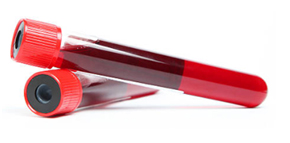 Using two vials of a patient’s blood, Guardant searches for DNA fragments among billions of cells. They digitally tag each DNA fragment and make millions of copies. Conventional sequencing methods introduce errors and false positives. Guardant says they reduce these errors by a thousand-fold.
Using two vials of a patient’s blood, Guardant searches for DNA fragments among billions of cells. They digitally tag each DNA fragment and make millions of copies. Conventional sequencing methods introduce errors and false positives. Guardant says they reduce these errors by a thousand-fold.
By understanding genomic alterations, or changes that occur within the DNA of cancer cells, your doctor may be able to recommend a targeted therapy to destroy the cancer, rather than more commonly used broad-based therapies, such as chemotherapy. They expect this process to be much more selective and effective in stopping the spread of cancer where other treatments have failed.
This test is in routine use for clinical testing of cancer patients—including prostate cancer patients with advanced or recurrent disease. The test studies a panel of 68 clinically relevant genes. Cell-free DNA is extracted from blood and sequenced.
The Guardant360 is referred to as a biopsy-free test. It is the first and only comprehensive non-invasive test for tumor sequencing that is in clinical use.
The test involves no pain, no recovery and it delivers results in 14 days or fewer. Biopsy-free tests like the Guardant360 could change the way physicians look at cancer, giving patients options they have never had access to.
Exercise Linked to Lower Mortality with Early Prostate Cancer
Men with localized prostate cancer—which represents the vast majority of new diagnoses—may have longer survival if they exercise regularly, according to a study recently published in Reuters Health.
The study reported that “regular moderate or vigorous physical activity was associated with 31 percent to 37 percent lower likelihood of death during the study, compared to more modest amounts of exercise.”
Ying Wang of the American Cancer Society in Atlanta, GA pulled data from a large, long-term study that focused on 7,000 men diagnosed with prostate cancer between 1992 and 2011. They found that men were more likely to have lower-risk cancers if they were more active before diagnosis. After diagnosis, the same levels of exercise were linked to lower risk of death from prostate cancer for all men. Walking was the most common exercise among those studied, followed by cycling.
Aside from the above study, three clinical trials being conducted at UCSF are studying the effects of physical activity in men with prostate cancer.
The American Cancer Society and the American College of Sports Medicine recommend at least 150 minutes of moderate physical activity, or 75 minutes of vigorous exercise each week. However, the UCSF lead researcher, Erin Van Blarigan, recommended that men with prostate cancer should work toward continuing to increase their physical activity to twice that amount.
Choose Your Hospital Wisely
Often people choose the hospital or medical center closest to their home when needing treatment. This isn’t always a wise decision. Infection control is becoming more and more of an important issue in that choice. Here are some facts on Sepsis, a life threatening illness caused by your body’s response to an infection.
Sepsis is the leading cause of death in U.S. hospitals, according to Sepsis Alliance, a nationwide advocacy group based in San Diego
More than 1 million people get severe sepsis each year in the U.S. according to the Centers for Disease Control, and up to 50 percent of them die from it.
It is also one of the most expensive conditions for hospitals to treat, costing $24 billion annually.
Any infection can trigger sepsis, and this infection is most common in seniors or people with weakened immune systems.
In an emergency, the closest hospital is probably the best choice. But when scheduling voluntary surgical procedures, it would be wise to choose a medical center that pays close attention to, and has an excellent record in infection control.
‘An American Sickness’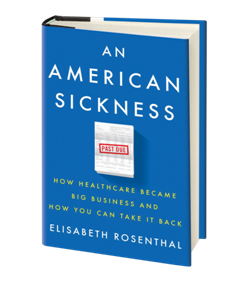
Many in the medical community are buzzing about a best-selling new book, An American Sickness, a shocking investigation into our dysfunctional healthcare system. We asked BOB member, Dr. Pat Greany, a biologist and retired university professor with an excellent analytical mind to review this book.
While Pat’s review exposes some egregious practices by many large healthcare providers, the author’s critique certainly does not apply to many of the medical centers we are familiar with that practice proton therapy, especially the institution with which we have had a close relationship for the past 17 years, Loma Linda University Health. LLUH is a nonprofit religious organization whose mission is to “Make Man Whole” physically, intellectually, emotionally, and spiritually with the purpose of continuing Christ’s healing and teaching ministry. Their clinical and administrative methods and practices are the antithesis of what is described in this book, and should be the model for others to follow.
Pat Greany’s review is below.
The following is a review of the new best-selling book, An American Sickness—How Healthcare Became Big Business and How You Can Take It Back by Dr. Elisabeth Rosenthal, a Harvard-trained MD and former practicing physician who became a journalist. Dr. Rosenthal uses her exceptional training, knowledge and experience to expose the increasingly greedy, self-serving “medical-industrial complex” in the U.S. Like another reviewer, I found her book revealing and disturbing. I also have some issues with her lack of focus on the need for us to take more personal responsibility for our own health. As
Pogo said on Earth Day, 1971, “We have met the enemy and he is us!” Sadly, Americans spend far more money on healthcare, per capita, than citizens of any other country ($9,237 per year), yet we rank #35 in healthcare according to the World Health Organization. U.S. Healthcare is ranked the worst performing among high-income nations!
As Dr. Rosenthal describes our healthcare situation, she provides numerous examples of egregious overcharges, such as a plastic surgeon charging $50,000 to put three stitches in the face of a toddler to close a minor facial cut (for which he was later censured by his professional organization). She provides lots of guidance re: How to avoid being overcharged by doctors, pharmaceutical companies, medical device manufacturers, HMOs and other insurers, as well as hospitals.
A recent article entitled, "The Sky-High Pay of Health Care CEOs” by Bob Herman of Axios states that some U.S. health care CEOs earn, on average, $20 million per year, mostly in the form of vested stock, which benefits them when stock prices increase. The former CEO of Gilead Sciences, earned $863 million in total compensation since the “Affordable Care Act” was enacted. Several other health care CEOs earned over $250 million. Herman discusses ways in which these CEOs are able to manipulate stock prices, further enriching themselves!
Dr. Rosenthal discusses the difficulties experienced in compelling health care providers to reform their practices as they use their vast resources to game the system with highly-paid consultants and lobbyists. She also cites examples of complicit government officials who commonly accept campaign contributions or other forms of consideration from entities they regulate.
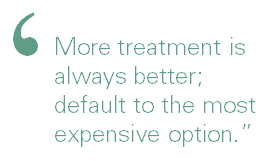 She identifies eight “Economic Rules of the Dysfunctional Medical Market,” the first of which states, “more treatment is always better; default to the most expensive option,” and unfortunately illustrates this with a bogus argument against the use of proton beam radiotherapy for prostate cancer, something we hear a lot these days! For this, she quotes from a story in The Wall Street Journal, which stated that one study of 30,000 patients with prostate cancer found that “proton beam therapy provided no long-term benefit over traditional radiation therapy, despite far higher costs.” The study in question is that of Yu et al., published in 2013, which used retrospective Medicare code data (billing records) and which has been discredited upon subsequent analysis. It is regrettable that Dr. Rosenthal’s literature review did not include more recent papers in favor of proton therapy for prostate cancer, specifically the paper by Bryant et al. (of the UF Health Proton Therapy Institute), which stated, “The Yu et al. Medicare-based study’s lack of treatment-related information (e.g. radiation dose, field size), lack of toxicity grading, and reliance on the presence of codes to detect a toxicity limits the strength of its conclusions.”
She identifies eight “Economic Rules of the Dysfunctional Medical Market,” the first of which states, “more treatment is always better; default to the most expensive option,” and unfortunately illustrates this with a bogus argument against the use of proton beam radiotherapy for prostate cancer, something we hear a lot these days! For this, she quotes from a story in The Wall Street Journal, which stated that one study of 30,000 patients with prostate cancer found that “proton beam therapy provided no long-term benefit over traditional radiation therapy, despite far higher costs.” The study in question is that of Yu et al., published in 2013, which used retrospective Medicare code data (billing records) and which has been discredited upon subsequent analysis. It is regrettable that Dr. Rosenthal’s literature review did not include more recent papers in favor of proton therapy for prostate cancer, specifically the paper by Bryant et al. (of the UF Health Proton Therapy Institute), which stated, “The Yu et al. Medicare-based study’s lack of treatment-related information (e.g. radiation dose, field size), lack of toxicity grading, and reliance on the presence of codes to detect a toxicity limits the strength of its conclusions.”
Overall, Dr. Rosenthal does a great job in diagnosing many problems in our treatment-oriented (rather than prevention-oriented) system and she prescribes many potential solutions. My problem with the book is that she doesn’t deal adequately with what many experts regard as primary factors leading to disease manifestation. Dr. David Servan-Schreiber focused on this in his book Anticancer, as we discussed in previous issues of the BOB Tales newsletter. He emphasized the need to take a preventive approach including: optimizing our diet (nutrition), exercising, avoiding toxins and stress reduction. An excellent film produced by Morgan Freeman based upon these concepts, The C-Word, is available on Netflix, along with many excellent documentaries I recommend highly, including, What the Health?, Sustainable, Food, Inc. and Food Choices. I promise they’ll get your attention and make you rethink your lifestyle. It is increasingly clear we all need to take more personal responsibility for our health, focusing on prevention rather than cure.
Blue Zones: Would we be in this situation if we were to adopt a more sustainable, healthier lifestyle? There are locales in the world known as Blue Zones, where folks live much longer than average. One of these is in Loma Linda, CA, which is home to one of the highest concentrations of Seventh-day Adventists. Adventists typically adhere to a plant-based, sustainable approach to diet, along with exercise and stress-reduction. Coincidentally, that’s where the first clinical use was made of proton beam therapy for prostate cancer at Loma Linda University Health. We should probably follow their example as they live about 10 years longer than average Americans.
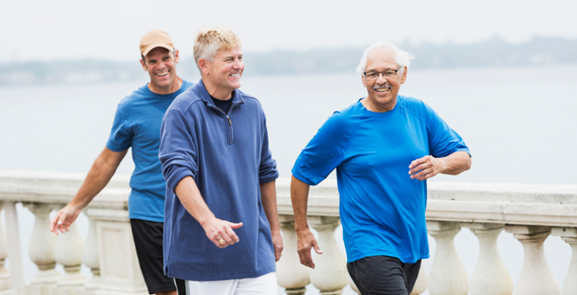
.gif)
We have been producing BOB Tales newsletters monthly for almost 17 years. There have been important articles that new members haven’t seen, and others may have forgotten. We are periodically re-running some articles from past newsletters. The following is from July 2003.
Each of Us Can Make a Difference
By Bob Marckini
Last month two men came to my house to do some painting. Kenny was African American and Joe was a Caucasian; his family emigrated from Western Europe. Both were in their 50s. I chatted with them during a break and asked if they were having annual physicals. Kenny said he has physicals about every three years. Joe couldn’t remember when he had his last physical, but said he planned to have one soon.
Then I asked if they knew about PSA. Neither had a clue. I told them about PSA, about prostate cancer, and about the importance of annual physicals and monitoring their PSAs. Joe told me his father died of prostate cancer.
Men at higher risk for prostate cancer include African Americans and those with a family history of prostate cancer. Both of these risk factors were present here. I shared this information with them, and reminded them that one out of six men is diagnosed with prostate cancer, and high-risk groups, which they represented, had an even greater probability. And, the earlier detected, the easier it is to deal with it. They both indicated they would schedule physicals soon and begin tracking their PSAs.
My wife Pauline often kids me because I frequently bring up the subject of PSA and prostate cancer when I meet someone new. I do it because I have knowledge that may help these men, and I might be able to make a difference in their lives.
We have almost 1,200 BOB members (in 2003). Imagine how many people’s lives we could impact if each of us raised the issue of PSA and annual physicals with just one man each month. In one year we would reach over 14,000 men. We know that one out of six of them, or 2,400 will be diagnosed with prostate cancer. If we influence only 10 percent of that number to catch their disease early, we will be saving lives.
So, next time you’re at a party and you’re introduced to someone new, just say, “Hello Bill, my name is George … So, what’s your PSA?”
Fight Prostate Cancer with Broccoli?
Bonus Flashback Article from June 2003:
Is broccoli on your menu this week? If not, adding it will bring a host of cancer-fighting compounds to your diet. According to research, a chemical that the body produces when digesting broccoli may thwart prostate cancer cell proliferation. The cancer-fighting substance is produced when the body digests indole-3-carbinol, a compound found in abundance in broccoli, kale, Brussels sprouts, and cauliflower. Do you ever wonder why these wonderful compounds aren’t found in ice cream, chocolate, and French fries?

Gleason 10, Treated 11 Years Ago
BOB member Chuck Bloodgood’s father died from prostate cancer. “He ignored it and it spread to his liver and bones,” Chuck told us. His brother also had prostate cancer and had a prostatectomy at age 69. “My brother is 91—he’s still here, but he’s been wearing diapers since his treatment ended.”
The Diagnosis
Chuck was diagnosed with prostate cancer in July 2006 at age 73. “It was aggressive—I was a Gleason 10,” he said. “I didn’t want to die and I certainly didn’t want to wear diapers for the rest of my life.” When Chuck’s urologist recommended surgery, he figured there must be other options. Incidentally, Chuck, an accountant, mentioned his diagnosis to a client who attended the Salmon, ID Seventh-day Adventist Church, which is a sister organization to Loma Linda University Medical Center in Loma Linda, CA, also an Adventist institution. Chuck’s client “insisted” he look into proton therapy treatment at Loma Linda University Cancer Center (LLUCC).
“After viewing a DVD that came in their patient orientation kit and some discussions with LLUCC’s staff, my decision was made,” Chuck told us. “I learned there was a proton treatment center closer to me, but I wanted to go to the place that started it all.”
.jpg) The Treatment
The Treatment
Chuck was surprised by the treatments. “It took me longer to put on my Johnny than it took to receive treatment,” he said. “I started counting the seconds that I was in my ‘cocoon’ and it took exactly 30 and I was done.” Chuck said his proton treatment was easy and painless; the fact that it was non-invasive was the most wonderful aspect.
While at LLUCC, Chuck and his wife Dee took advantage of the Drayson Fitness Center to swim and work out. They also attended support groups where Dee made a lot of friends. “The other ladies took good care of my wife,” Chuck said. “There were many other spouses staying in the vicinity and they developed a great camaraderie.
Back Home
Chuck’s pre-treatment PSA was 9.8. His first post-treatment PSA was 0.06. “I had my PSA checked this past June,” he shared. “And after 11 years, guess what it is? You guessed it—0.06”
Back at home in Idaho, Chuck spends a lot of time counseling men about proton therapy for prostate cancer. Most of the men he’s spoken with have traveled to Loma Linda for treatment. “They have all contacted me to thank me—each of them is cancer free and feeling well,” Chuck said. “What more can I say? There isn’t any other treatment for prostate cancer in my opinion. I thank God for Loma Linda.”

Thirteen Years of “Thank You”
As mentioned in the opening memo, October 27 is “Navy Day,” established to give recognition to the naval service. We have in our group more than 50 members who served in the Navy. One of them is Capt. Fred Spruell from Paradise, CA. Fred served more than 31 years in the Navy, commanding three destroyers, and a large shore command. The Navy sent him for further education at the Navy Postgraduate School in Monterey, where he received an MS in Computer Science, and subsequently served at NATO in Belgium as Fleet Technical Director in Hawaii on the staff of the commander, U. S. Pacific Fleet, and finally, as Commander of the Naval Data Automation Center in San Francisco.
The Diagnosis
Fred was diagnosed with an enlarged prostate in 1988, at the age of 58, and experienced frequent bouts of prostatitis and other urinary difficulties. These issues lasted for 16 years. He’d had several biopsies over the years, but all were negative until 2004 when he was diagnosed with Gleason 5 prostate cancer. “Lucky” for Fred, he was an Adventist and had heard about proton therapy at Loma Linda University Health in 1992. “I decided back then, if I were ever diagnosed with prostate cancer, I’d go to Loma Linda for proton treatment,” Fred told us.
When Fred informed his urologist about his decision to have proton therapy, “he got up and walked out of the office and slammed the door,” Fred said. “It was the most unprofessional conduct I had ever witnessed from a medical professional.”
Treatment
Fred was treated at LLUCC from August to November 2004. During that time he played golf “every day of my treatment and never had one moment of difficulty.” He and his wife thoroughly enjoyed their “proton vacation.” Since then, Fred has been extremely active with a “wonderfully vibrant life.” Sadly, his wife passed in 2013. Fred remarried in 2015. Now, at the age of 81, he and his wife are very active in both their community of Paradise, and their church. “We sing in the choir and also love karaoke,” Fred said. He also plays golf a few times a week. “I shot my age, last week. Who says protons don’t work?!”
Giving Back
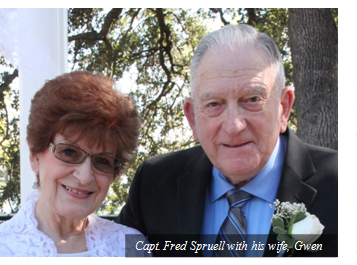 We were recently informed that Fred has been making monthly gifts to proton research since his treatment ended—that’s 13 years of giving. “I’m thankful,” Fred told us. “And I appreciate all the work the BOB does, including the BOB Tales newsletter which is a tremendous tool.” Fred forwards the newsletter regularly to several urologists and radiation oncologists.
We were recently informed that Fred has been making monthly gifts to proton research since his treatment ended—that’s 13 years of giving. “I’m thankful,” Fred told us. “And I appreciate all the work the BOB does, including the BOB Tales newsletter which is a tremendous tool.” Fred forwards the newsletter regularly to several urologists and radiation oncologists.
Fred has also presented to several community groups on the benefits of proton therapy for prostate cancer. “I was a Director for the Coronary Health Improvement Program in Paradise from 2002 until 2014. After my treatment ended, I presented a slide show to over 800 graduates of the program during that time frame,” Fred said. “A number of the male graduates of CHIP subsequently had proton treatment.” Fred also presented to local cancer support groups as well as Rotary and several other community groups. He told us about 15 men have had proton therapy at LLUCC as a result of his presentations.
“Proton therapy is, without any doubt, the absolute best treatment for prostate cancer, in my opinion,” Fred said.
Estate Planning Hints
BOB Member Ron Hendricks is Director of Gift Planning for Trinity Western University. He regularly copies us on his “News from Ron” mailings, which are helpful hints on estate planning to the readers of his newsletters. We have found Ron’s suggestions to be timely and beneficial. With his permission we periodically share some of his wisdom with our membership. This segment is called …
Increase Your Income & Bypass Capital Gain Tax
Susan and Kevin bought a vacant lot along Lake Michigan many years ago. They had planned to build a second home so that their children could spend their summers along the lake. However, as time went on, Kevin's job kept him in town and the children grew up before Susan and Kevin had the financial resources to build on the land.
Kevin: Over the years, that lot increased in value. It is worth much more than what we paid for it. We paid about $40,000 for the lakeside property and it is worth almost $200,000.
Susan: The lot has gone up greatly in value, and with the children out of the house we were thinking of selling the property. We wanted to sell, but we also wanted to avoid paying so much in tax on the sale. We were thinking of making a gift of 25 percent of the property to our favorite charity.
Kevin: I happened to be talking to a CPA at a community luncheon. He mentioned that we could probably give away about twice as much with almost the same cost if we gave 25 percent of the property (prior to the sale) rather than writing a check after the sale.
After talking to our tax adviser, we discovered that if we gave a 25 percent interest in the property to charity, we would receive two benefits. We would get an income tax deduction for the value of our gift plus save on capital gains tax on the 25 percent interest given away.
Susan: That’s what we decided to do. By giving charity a 25 percent interest in the property prior to the sale we saved the capital gains tax on that part. The deduction on that part offset a large portion of the tax on the $150,000 we received when the property actually sold. We are very pleased with the "double benefit" from giving the property, and our favorite charity received $50,000, a very nice gift.
BOB Comment: If you have appreciated assets you may want to consider doing something like this. If so, we encourage you to consider giving to our favorite charity: Loma Linda University Heath’s Vision 2020 and the Robert J. Marckini Endowed Chair for Proton Therapy Research.
How to Contribute to Proton Research
- Donate Online: Visit the LLUCC website. Make sure the “Designation Type” is set to “Proton” and the “Designation” is set to “Robert J. Marckini Chair."
- Send a Check: Make your check out to “LLUCC Proton” with “Marckini Chair” on the memo line and send to: LLUH, Office of Philanthropy, P.O. Box 2000, Loma Linda, CA 92354.
- Make a Call: Contribute by phone. Contact Elvia DeHaro at 909-558-5010
- Make a Future Gift: Contact Todd Mekelburg at the Office of Planned Giving at Loma Linda University Health at 909-558-5376 or [email protected].
- Other Ways to Give: Contact Matt Miller at the Office of Philanthropy at Loma Linda University Health at 909-558-3582 or [email protected].

Attention: Supplement Takers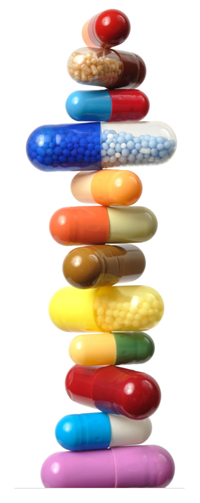
While dietary supplements may be beneficial to your health, they can also carry great risks—like complications during surgery, harmful drug interactions, or serious side effects. Before you begin taking supplements, be sure to speak with your doctor. Also, read the following tips.
- Do your homework: Supplements are not drugs; they don’t prevent, treat, or cure diseases, nor are they required to follow the same strict regulations as prescription medicines. The FDA doesn’t have the authority to review dietary supplements. Rather, manufacturers and distributors are responsible for ensuring the safety of their products. That means that there are no guarantees how safe they are. It’s important to find reliable information before starting a supplement. Check government sites like the National Institutes of Health or talk with your pharmacist.
- Beware of false claims: Not all supplements do what they claim. Watch out for the word “natural.” While some natural herbs may be considered safe, they can become contaminated during processing or may be intentionally contaminated with prescription drugs.
- Keep your doctor informed: Any dietary supplement regimen will vary from person to person. Talk with your doctor before you start, and keep him or her up to date on any changes.
- Follow directions carefully. Never take more than the recommended dose or combine supplements. Avoid taking supplements with other medications, or substituting supplements for medication. Also, read the package warning labels. Again, speak with your doctor before starting any supplements; he/she can also assess your risk of taking supplements if you have an existing condition or of combining it with other medications.
- Don’t take supplements with the following ingredients: There are 15 ingredients found in dietary supplements that you should always avoid, according to a Consumer Reports study. These dangerous ingredients have the potential to cause kidney and liver failure, paralysis, seizure, possible death, and more.
Aconite
Caffeine Powder
Chaparral
Coltsfoot
Comfrey
Germander
Greater Celandine
Green Tea Extract Powder
Kava
Lobelia
Methylsynephrine
Pennyroyal Oil
Red Yeast Rice
Usnic Acid
Yohimbe
Read more about the five things you need to know about supplements, or learn more about the Consumer Reports findings on the 15 supplement ingredients to avoid, including specific risks linked to each ingredient.
Food Behaviors that Help Prevent Heart Disease
According to the American Heart Association, there are seven behaviors you can follow to help ward-off heart disease. Five are related to diet and nutrition:
- Eat plenty of fruits and vegetables. The AHA recommends at least 4 ½ cups a day.
- Eat fish, at least two servings a week (Some use fish oil supplements).
- Eat fiber-rich whole grains, at least three servings daily of about one ounce (roughly once slice of bread)
- Reduce sodium to fewer than 1,500 milligrams a day
- Reduce consumption of sugar-sweetened beverages to no more than 36 ounces a week.
Several of these recommendations are excellent for preventing cancers and other diseases as well.
Organic= Healthy?
Just because something is labeled organic doesn’t mean it’s healthy, according to MoreContentNow Health Tips. This is especially true of snacks such as cookies, crackers, chips, and candies. These foods often have the same amount of sugar and number of empty calories as non-organic versions.
The Diabetes Epidemic
More than 29 million adults in the U.S. have diabetes. Unfortunately, 25 percent are unaware, according to the Centers for Disease Control. Add to that the fact that another 86 percent of U.S. adults are classified as having pre-diabetes, a condition characterized by higher-than-normal blood sugar levels that presents higher risk for diabetes. The good news is that pre-diabetes can often be reversed with proper care, according to the Mayo Clinic.
If you have been feeling inordinately thirsty, noticing blurred vision, finding minor cuts difficult to heal, you may have diabetes and should seek medical attention. Doctors also recommend that you have your blood sugar level monitored annually.
Series: “Make Vegetables Taste Good”
This is the 13th segment on a subject that’s consistent with our Anticancer series that began in October 2016. We made it our mission to find recipes that make the most healthful vegetables taste delicious. And, we’ve tried them all!
Quinoa and Black Beans
Deb grabbed this recipe from Loma Linda Health’s “Living Whole Recipes.” Note that the recipe is apparently for 10 people, but when Deb made this dish, she used one can of beans, rather than the recommended two, and she and her husband had it for dinner two nights in a row and it was the perfect amount with a side salad. We think it would also taste great in a multigrain tortilla!
Quinoa has more and better protein than most grains (17). It also contains all the essential amino acids that we need. The health benefits of black beans come from a few components—protein, fiber, antioxidants, and micronutrients. Dried or canned are equally nutritious.
|
|
Heat the oil in a medium saucepan over medium heat. Stir in the onion and garlic, and sauté until lightly browned. Mix the quinoa into the saucepan and cover with vegetable broth. Season with cumin, cayenne pepper, salt, and pepper. Bring the mixture to a boil. Cover, reduce heat, and simmer for 20 minutes. Stir frozen corn into the saucepan, and continue to simmer about 5 minutes until heated through. Mix in the black beans and cilantro.

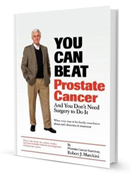
“Hope” and “Peaceful Sleep”
The first week in October is “Great Books Week.” We think there’s a book that fits this category: You Can Beat Prostate Cancer: And You Don’t Need Surgery to Do It. Tens of thousands are in readers’ hands; 11 proton centers distribute it to prospective patients; it is ranked No. 3 out of 9,120 Amazon results on a search for “prostate cancer;” and it’s changing people’s lives every day. Just this week we were contacted by a recently diagnosed man who told us the two weeks following his diagnosis were “the worst of my life,” but then he “researched my tail off and discovered Bob Marckini’s book.” After reading half of it, this gentleman said he’d had his first night of peaceful sleep because the book had given him hope. He said, “Proton therapy is the only thing that looks right for me.”
We’re not the only ones who think Bob’s book is great. Below is a recent Amazon review.
 An Excellent Resource
An Excellent Resource
I was diagnosed with prostate cancer a few months ago and was overwhelmed with trying to determine what the best next steps should be. After doing some research online, I decided to purchase Bob Marckini's book and was very glad I did. It was thorough, answered many questions I hadn't even thought to ask yet, and was easy to understand. Mr. Marckini's book is an extremely helpful resource for those facing the tough decision on how best to treat their cancer. —David L., 7/16/17
Finding Bob’s book after searching for “prostate cancer” on Amazon is how most of our members learn about proton therapy. If you found Bob’s book helpful in your journey to proton therapy, please help others find it by posting a review on Amazon. Click on the “Write a Review” button.
You Can Beat Prostate Cancer: And You Don’t Need Surgery To Do It
Buy Online, in Bulk or in Spanish
Online: Paperback: $19.00--•--Kindle: $9.99--•--NOOK Book: $9.99--•--Apple iBook: $9.99
In Bulk: Conctact us for a discount price list. Proceeds from book sales support proton therapy research through the Robert J. Marckini Endowed Chair at LLUCC.
In Spanish: Buy the print version or in eBook format.

Did You Know?
- Vending machines are twice as likely to kill you as a shark is.
- Coconuts kill more people than sharks every year. So do cows.
- The probability of you drinking a glass of water that contains a molecule of water that also passed through a dinosaur is almost 100 percent.
- Honey is made from nectar and bee vomit.
- Popsicles were invented by an 11-year-old in 1905.
- Apples, like pears and plums, belong to the rose family.
- The official state vegetable of Oklahoma is the watermelon.
- Peas are one the most popular pizza toppings in Brazil.
- There are over 7,500 varieties of apples throughout the world, and it would take you 20 years to try them all if you had one each day.
- The twists in pretzels are made to look like arms crossed in prayer.

Last Month’s Brain Teaser—A Tough One!
What do the following 23 words/phrases have in common?
Thou, I, not, that, we, to give, who, this, what, man/male, ye, old, mother, to hear, had, fire, to pull, black, to flow, bark, ashes, to spit, worm.
Hint: Two of the 23 words provide an important clue.
Answer: They are considered to be the oldest words in the English language. A research team led by Mark Pagel at the University of Reading in England has identified 23 “ultra-conserved words” that have remained largely unchanged for 15,000 years. Learn more.
Winner: A BOB Tales brain teaser first: Although many readers wrote in, not one had the correct answer. Was this one too hard?
New Brain Teaser—A Riddle
If you have me, you want to share me. If you share me, you haven’t got me. What am I?
Send your answer to [email protected] for a chance to win a signed copy of Bob Marckini’s book, You Can Beat Prostate Cancer.
Dangerous Food
A well-known doctor was giving a speech to a large crowd; the crowd was listening in awe. The doctor said:
The things we put into our stomachs should have killed most of us years ago. Red meat is full of steroids and dye. Soft drinks corrode your stomach lining. Some Chinese food is loaded with MSG. High trans-fat diets can be disastrous and none of us realize the long-term harm caused by the chemicals and germs in our drinking water. But there is one thing that is the most dangerous of all and most of us have eaten this, or will eat it in our lifetime. Can anyone here tell me what food it is that causes the most grief and suffering for years after eating it?
After several seconds of quiet, a 70-year-old man in the front row raised his hand, and softly asked, “Wedding cake?”
The Charmer
The person sitting next to me on a flight was an attractive woman. Ever the charmer, I used one of my favorite pick-up lines on her. I asked, “Does the airline charge you extra for sitting next to good looking men?”
“Yes,” she replied, “but obviously I was unwilling to pay.”
Teacher, Tax Collector, and Politician
A teacher, a tax collector, and a politician all die and want to enter the Pearly Gates. St. Peter greets them and says, “If you want to enter these pearly gates, each of you will have to answer one question based on a historical event that everyone knows about.” They all agreed, and St. Peter started with the teacher. He asked, “A large ship sank on April 14, 1912 when it hit an iceberg. What was the name of that ship?”
“That’s easy,” said the teacher. “It was the Titanic.” “Good,” St. Peter said. “You may enter.”
Next he asked the tax collector, “How many people died when the Titanic sank?” After a little thought, the tax collector said, “1,503.” “That’s correct,” St. Peter said. “1,503 people died on the Titanic.”
Then he looked at the politician and said, “Name them.”

Quote of the Month:
“We can’t help everyone, but everyone can help someone.” —Ronald Reagan


How Old is Grandpa?
One evening a grandson was talking to his grandfather about current events. The grandson asked his grandfather what he thought about the shootings at schools, the computer age, and just things in general.
The grandfather replied,
Well, let me think a minute … I was born before television, penicillin, polio shots, frozen foods, Xerox, contact lenses, Frisbees, and the pill. There were no credit cards, laser beams, or ball-point pens. Man hadn’t invented pantyhose, air conditioners, dishwashers, clothes dryers; and the clothes were hung out to dry in the fresh air.
Space travel was only in Flash Gordon books. Your grandmother and I got married first, and then lived together. Every family had a father and a mother. Until I was 25, I called every woman older than me, “ma’am.” And after I turned 25, I still called policemen and every man with a title, “Sir.”
We were before computer-dating, dual careers, daycare centers, and group therapy. Our lives were governed by the Bible, good judgment, and common sense. We were taught to know the difference between right and wrong and to stand up and take responsibility for our actions. Serving your country was a privilege; living in this country was a bigger privilege.
We thought fast food was eating half a biscuit while running to catch the school bus. Having a meaningful relationship meant getting along with your cousins. Draft dodgers were those who closed front doors as the evening breeze started. Time-sharing meant time the family spent together in the evenings and weekends, not purchasing condominiums.
We never heard of FM radios, tape decks, CDs, electric typewriters, yogurt, or guys wearing earrings. We listened to Big Bands, Jack Benny, and the president’s speeches on our radios. And I don’t ever remember any kid getting drugged-out listening to Tommy Dorsey. If you saw anything with “Made in Japan” on it, it was junk.
“Making out” referred to how you did on your school exam. Pizza Hut, McDonald’s, and instant coffee were unheard of. We had 5 & 10-cent stores where you could actually buy things for 5- and 10 cents. Ice cream cones, phone calls, rides on a streetcar, and a Pepsi were all a nickel. And if you didn’t want to splurge, you could spend your nickel on enough stamps to mail a letter and two postcards. You could buy a new Ford Coupe for $600, but who could afford one? Too bad, because gas was 11 cents a gallon.
In my day, “grass” was mowed; “coke” was a cold drink; “pot” was something your mother cooked in; and “rock music” was your grandmother’s lullaby. “Aids” were helpers in the principal’s office; “chip” meant a piece of wood; “hardware” was found in a hardware store, and “software” wasn’t even a word.
And we were the last generation to actually believe that a lady needed a husband to have a baby. No wonder people call us “old and confused” and say there’s a generation gap.
How old do you think I am? I bet you have this very old man in mind. If so, you are in for a surprise. Read on to see—pretty scary if you think about it, and pretty sad at the same time. Are you ready?
This man would be only 72 years old as of January 2017 (born just before the end of World War II in 1945).
To put this in perspective, Bob Marckini is 74!
Low PSAs to all,
Bob Marckini and Deb Hickey
To print the BOB Tales newsletter or view the newsletter with a larger font size, click here for the PDF file.
NO MEDICAL ADVICE: Material appearing here represents opinions offered by non-medically-trained laypersons. Comments shown here should NEVER be interpreted as specific medical advice and must be used only as background information when consulting with a qualified medical professional.
